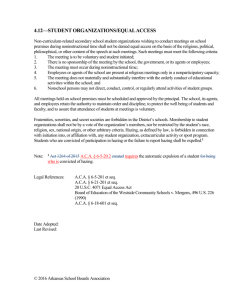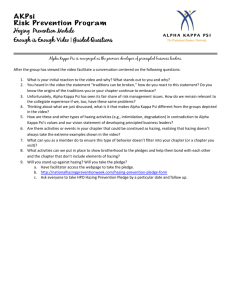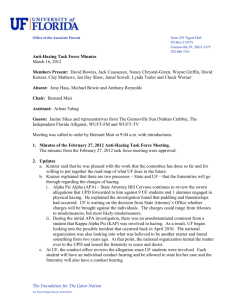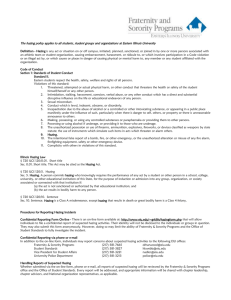Team6Alumni
advertisement
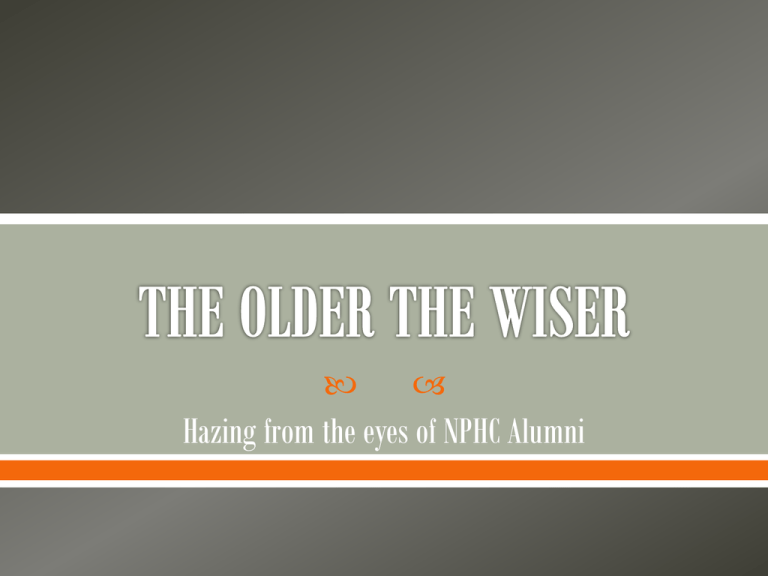
Hazing from the eyes of NPHC Alumni Kerene Nelson Kourtney Berry Purhnel Meek Kathrine Nicolas Winnie Moime Captain Co-Captain/ Optimist Time angel Skeptic Recorder The purpose of our research project is to gain insight from alumni National Pan-Hellenic Council members on their views on hazing and to see if they would be willing to help with changing the psychological mindset of students. our target public The National Pan-Hellenic Council, Incorporated (NPHC) is currently composed of nine (9) International Greek letter Sororities and Fraternities: o o o o o o o o o Alpha Kappa Alpha Sorority, Inc. Alpha Phi Alpha Fraternity, Inc. Delta Sigma Theta Sorority, Inc. Zeta Phi Beta Sorority, Inc. Iota Phi Theta Fraternity, Inc. Kappa Alpha Psi Fraternity, Inc. Sigma Gamma Rho Sorority, Inc. Phi Beta Sigma Fraternity, Inc. Omega Psi Phi Fraternity, Inc. NPHC promotes interaction through forums, meetings and other mediums for the exchange of information and engages in cooperative programming and initiatives through various activities and functions. Our group decided to chose alumni because they have more insight and a greater respect from the undergraduate chapters. They have had time to reflect on their experiences. http://rattlernation.blogspot.com/2009/03/famu-students-leave-with-29742-indebt.html The overall campaign goal of our project is to decrease hazing at Florida A&M University To inform Divine Nine alumni that they play a role in addressing hazing by December 2012. To persuade 40% of alumni that they should be active in eliminating hazing at FAMU. To get 10%of alumni to commit to speaking to a chapter by September 2012 about alternatives to hazing. Develop a survey to gain more insight on the perception of hazing. Educate and emphasize to future "pledges" the importance of standing up for their personal rights. Seek out opinion leaders and get them to speak about some of their hazing experiences. Inform pledge leaders: and those involved with the intake process that a prophyte/alumni from the grad chapter MUST be present at each pledging scenario. Require that every person who is a victim of hazing reports it immediately! In order to develop a survey, we have to have a purpose. We have to have measurable objectives to measure: To whom, For what, How much and By when. Conduct seminars that show the ramifications and mental impact hazing has on an individual. Through the survey, we will have a database of people interested in our initiative. From there we will personally invite them to participate in our efforts. To inform alumni about their mandatory presence, we will use email, and personally call chapter heads. Require that each chapter head has an anonymous drop box to report any instance of possible hazing, thus decreasing the likeliness a chapter would participate in any demeaning activities. First, we decided our target audience Next, we developed our questions Last, contacted our public This is a view of our survey that was distributed to 100 Alumni from different universities all over the United States. Our survey was comprised of 12 questions Most of the alumni surveyed were still relatively young and still connected to the chapter so they had a more precise knowledge of what’s going on. Many attended FAMU so they are more connected to the school and students and would be more sympathetic to the situation at hand for their Alma Mater. Although many alumni surveyed agreed that activities mentioned were considered hazing, a few did not which tells us some still believe hazing is a proper way to being members into an organization. 80% surveyed confessed to have known someone who was a victim, hazer or witness to hazing. One can infer that hazing is something that has been around for ages and has been some sort of a tradition in the Greek and FAMU community. 30% of those agreed that being a victim, hazer or witness to hazing better prepared them to be a member of the organization. 53% percent say that their undergraduate chapter’s intake process does not need any sort of changes so the processes in place, if they do include hazing, have been set there for a reason. However, the survey did get our group to reach our goal of having alumni commit to speaking with undergraduates about hazing alternatives. 41% were highly likely to speak about preserving their organization’s legacy and 38% would offer their services to help chapter create new policies that do not involve hazing. Brewer, B. W., Cornelius, A. E., Linder, D. E. & Van Raalte, J. L. (2007). The relationship between hazing and team cohesion. Journal of Sport Behavior, 30(4), 491-507. Retrieved from Academic Search Complete Database. This author’s purpose was to evaluate how hazing is associated with team cohesion. In the observation, athletes were told that the more team-building activities they engaged in, the more socially cohesive they would be. Some of those activities may have been getting yelled at, kidnapped and even beaten. However, researchers’ results found that theory to be quite the opposite: Hazing incurs less team cohesion than more. Abdulrehman, R. Y. (2007). The cycle of abuse in sport hazing: Is it simply a case of boys being boys? (Doctoral dissertation). Available from ProQuest Dissertations and Theses database. Male students at the University of Manitoba were studied on a psychological level about hazing. The results showed that males who were victims of sexual abuse were more likely to become abusive to others. Abdulrehman says that sexual aggression is common among male athletes and that emotional, physical and sexual abuse were present in the hazing instances studied. Allen, E.J. (2009). Hazing in view: College students at risk: Initial findings from the national study of students hazing. Collingdale, PA: DIANE Publishing Co. Studies found by the National Study of Student Hazing shows that hazing occurs in, but extends beyond, the typical sports and Greek-letter organizations. It also explains what hazing may be considered such as; alcohol consumption, humiliation, isolation, sleep-deprivation and sex acts. Nuwer, H. (2001). Wrong of passage: Fraternities, sororities, hazing, and binge drinking. Bloomington, IN: Indiana University Press. The meaning behind hazing and the attitudes that contribute to the common patterns are from what the mind considers rituals. Baler, J., & Williams, P. (1983). Fraternity hazing revisited: current alumni and active member attitudes towards hazing. Journal of College Student Personnel, 24(4), 300-308. What I learned from this journal article was that alumni members of organizations including fraternities and sororities did not see anything wrong with hazing. They felt as though if done correctly it actually serves a good purpose for the organization. Maclachlan, J. (2005). Dangerous traditions: Hazing rituals on campus and university liability. JOURNAL OF COLLEGE AND UNIVERSITY LAW, 26(3), 511-548. What I learned from this annotated was that universities should not tolerate these acts to begin with but if something regarding hazing from something small to an allegation to something huge like the death and that universities will be held accountable from any injuries or damages. Bilyeau, A., & Feder, J. (2004). Hazing In Schools: A Legal Analysis. CRS Report for Congress, 108(2), 12. Retrieved February 9, 2012, from the Lexis Nexis database. This legal analysis investigates the state and federal laws of hazing. It is mainly structured around hazing and concentrates on hazing in education settings. This article is helpful to me in my research because it gave me the precise definition of hazing. Iota Xi Chapter of Sigma Chi Fraternity v. Patterson, No. 08-1417, UNITED STATES COURT OF APPEALS FOR THE FOURTH CIRCUIT, 566 F.3d 138 This court case was relevant to me because it is an example of a predominantly white institution and is showcases a predominantly white Greek letter organizations. This federal court case led to the suspension of the chapter after several incidents had occurred. Herdt, G. (1990). Secret Societies and Secret Collectives. Oceania, 60(4), 360. Behind closed doors, hazing occurs within many organizations as a part of a "traditional" initiation process. Erickson, B. (1988). Secret societies and social structure. Social Forces, 60(1), 188. Many people willingly decide the become a victim to hazing in order to rise to higher ranks within specific organizations. Shutting down an organization will not get rid of the mentality Immediately inform students The organization under investigation should make sure that they are completely open for contact to prevent it from looking like a cover up. University’s president should not take long to respond to the media Organization need to contact the media, not have the media contact them University should think of initiatives to prevent the situation from happening again. Hold the correct individuals accountable once full story and evidence is gathered not “hearsay” individuals. Find the source Do not give too many details until all the facts are gathered Do not FIRE the organization leader until after full investigation. Get educated on what hazing actually is, BY LAW Make the organization, don’t let it make you! Know yourself before you join organizations Safety first! Know the difference between discipline and hazing https://www.surveymonkey.com/s/FJYX9R6
